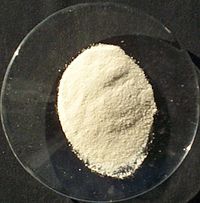
Photo from wikipedia
In-plane tungsten oxide nanostructures, including hexagonally patterned cylinders and holes in a matrix, were fabricated via sequential infiltration synthesis (SIS) on self-assembled block copolymer templates. Using the tailored morphology and… Click to show full abstract
In-plane tungsten oxide nanostructures, including hexagonally patterned cylinders and holes in a matrix, were fabricated via sequential infiltration synthesis (SIS) on self-assembled block copolymer templates. Using the tailored morphology and porosity of these model electrodes with in situ grazing incidence small-angle X-ray scattering, the intrinsic structural change of nanoscale active materials during the conversion reaction of WO3 + 6Li ↔ W + 3Li2O was investigated at controlled electrochemical conditions. Reversible electrode volume expansion and contraction was observed during lithiation and delithiation cycles, respectively. The potential where the electrode's thickness expansion started was ∼1.6 V, which is close to the thermodynamically expected one for the conversion reaction of WO3 with lithium (1.65 V). The temporal evolution of the electrode volume at constant electrode potentials revealed high overpotential for bulk lithiation and slow conversion reaction kinetics, despite the tailored porosity of the SIS electrodes. Oxide cylinders showed a smaller overall electrode thickness change, likely due to unconstrained lateral volume change, as compared to a matrix with holes. On the other hand, better connectivity and guided volume change of the latter electrode morphology provided improved cycling stability. In addition, heterogeneity in an electrode, from internal pores and density gradients, was found to aggravate the fragmentation of the electrode during the conversion reaction. Insights into oxide conversion reaction kinetics and the relationship between electrode mesostructure and cycling behavior obtained from this study can help guide the more rational design of conversion electrodes for high-performing batteries.
Journal Title: ACS nano
Year Published: 2022
Link to full text (if available)
Share on Social Media: Sign Up to like & get
recommendations!